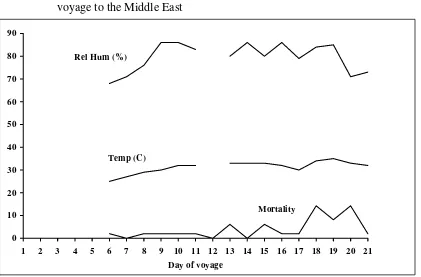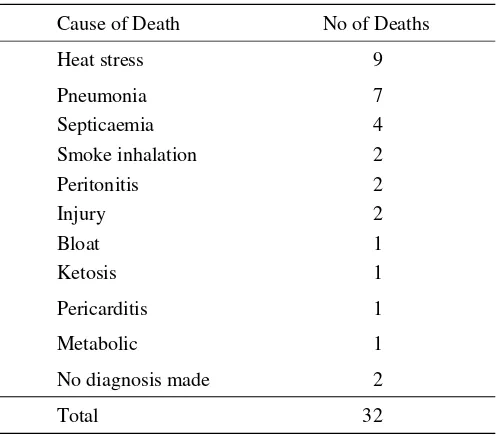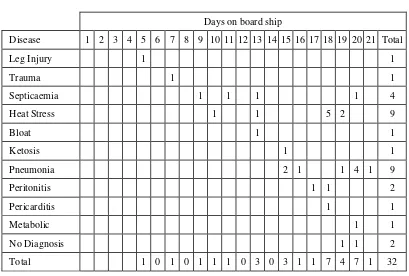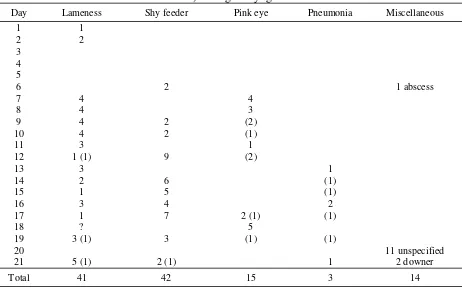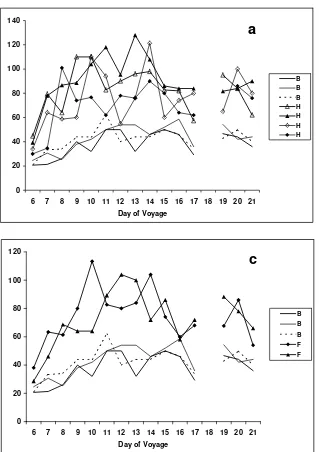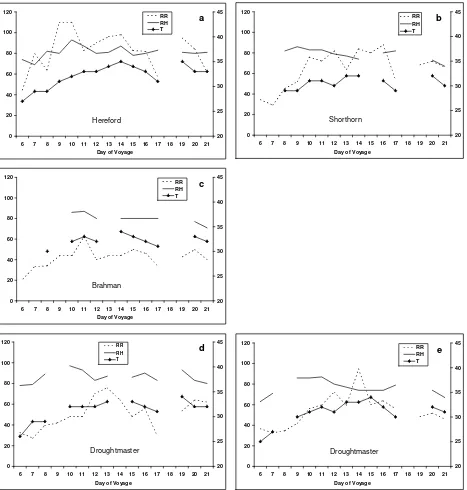SBMR.004
Shipboard mortality and morbidity
study –Phase 2
Final Report prepared for MLA and Livecorp by:
Agriculture Western Australia RT Norris, B Madin & RB Richards Ph: (08) 9368 3637
Fax: (08) 9367 6248
Email: [email protected] 10 September 1999
Meat & Livestock Australia Ltd Locked Bag 991
North Sydney NSW 2059
Tel: 02 9463 9333 Fax: 02 9463 9393
ISBN 1 74036 1237
MLA makes no representation as to the accuracy of any information or advice contained in this document and excludes all liability, whether in contract, tort (including negligence or breach of statutory duty) or otherwise as a result of reliance by any person on such information or advice. © Meat and Livestock Australia (2000)
Investigation of Cattle Deaths and Illness
during Sea Transport from Australia
Voyage 2
RT Norris, B Madin and RB Richards Agriculture Western Australia
September 1999
Background
The live cattle trade from Australia to the Middle East has expanded rapidly since 1995 and this has helped to reduce the impact of the downturn in cattle exports to Asia. For example, live cattle exports to the Middle East increased by about 100% annually between 1995 and 1998. Exports to Egypt were valued at approximately $100 million in 1998/99, up from about $22 million in 1997/98 (ABS).
Although cattle death rates during sea transport have generally been low, high mortality incidents on ships have focused attention on the animal welfare aspects of this trade. This attention, together with the lack of scientific information about the live cattle trade, has led to initiatives aimed at improving animal welfare and reducing mortality.
A report into the live cattle trade by Norris and Creeper (1999) showed that the overall death rate was 0.22% among 2.5 million cattle exported by sea from Australia between 1995 and 1998. The death rates were highest on long haul voyages to Mexico (0.88%) and to the Middle East and North Africa (0.68%) with lowest rates on short voyages to South East Asia (0.09%). For Middle East voyages, Fremantle was the main port of loading followed by Darwin, Adelaide and Portland. The average death rate of cattle exported from southern ports was 3 times that of cattle exported from northern ports (0.74% for southern ports, 0.26% for northern ports).
Clinical observations by veterinarians on several voyages in the latter half of 1998 indicated that Bos indicus cattle coped better with the hot, humid conditions on ships than Bos taurus cattle. Several veterinarians considered that poor ventilation predisposed to heat stress although it was recognized that the problem was multi-factorial in nature. It was also
considered that a lack of air flow was more important than temperature and relative humidity alone except in extreme conditions.
The report made several recommendations to improve the welfare of the cattle and for further investigations into various aspects of the industry (see Appendix 2). Among these was a recommendation for a detailed investigation into the causes of cattle deaths and illness during sea transport. The present study was undertaken to pursue this recommendation.
Objectives
1. Determine the cause(s) of cattle deaths and illness during sea transport from Australia to the Middle East.
Methods
General: The study was undertaken aboard a ship which loaded cattle only at Port Hedland and cattle and sheep at Fremantle in May 1999, and arrived at Aqaba, Jordan in June. Day 1 of the voyage was taken as 24 May 1999 after completion of loading at Port Hedland. The ship carried 4,905 cattle, mainly steers and bulls, with an average liveweight of approximately 350kg. The cattle loaded at Port Hedland (2,092) were mostly Brahman or Bos indicus-infused animals sourced from pastoral areas of Western Australia while those loaded at Fremantle (2,813) were both Brahman-type and Bos taurus animals (Shorthorn cross, Hereford cross and Friesian) from pastoral and agricultural areas of the state.
Ship and Deck Layout: The ship is a converted container/car carrier and the livestock are housed in 5 fully enclosed decks below the main deck and 4 decks above the main deck which together with the main deck are all open-sided. There are 5 cattle decks and each is divided into 2 to 4 holds. A schematic representation is provided in Appendix 1. The pens are laid out lengthways within each hold in paired lanes separated by walkways. There were 367 cattle pens which varied in area but were mostly approximately 20m2. The cattle were penned at densities about 10% below those recommended by the Australian Maritime Safety Authority.
Necropsy Technique: Cattle were necropsied as soon as possible after death (usually within 2 hours of death). A standard necropsy technique was performed and tissues from the
following organs were fixed in formalin: liver, kidney, lung, small and large intestine, spleen, rumen, abomasum and heart. Any lesions in other tissues detected during the necropsy were also sampled. The brain was sampled in cases where the cause of death was not determined by gross pathological examination, or where the history suggested neurological clinical signs. A full description of gross pathology was recorded on a standardised form following each necropsy. Tissues fixed in formalin were returned to Australia for histopathological examination at Agriculture WA’s Animal Health Laboratories, South Perth.
Environmental Monitoring: Temperature and relative humidity were recorded every 15 minutes by data loggers placed in separate locations throughout the cattle pens. The loggers began recording on Day 6, the first day after leaving Fremantle.
Additionally, temperature and relative humidity were recorded using wet-dry bulb
thermometers at specific locations within the holds. Measurements were taken between 1500 and 1700 hours.
Respiratory rates: Sixteen pens were chosen for respiratory rate observations on departure from Fremantle and were selected to cover a range of the pen types and cattle breeds on the ship. On two occasions the actual pen being observed was changed to accommodate movements in cattle. Recordings were usually made at the same time each day (1500-1700 hrs.), at a time intended to minimise interference from other activities on the ship.
Respiratory rates were counted from outside the pen by a veterinarian. The cattle were
similar cattle. Furthermore, in some pens a great range of rates was observed across breeds, and in such cases the cattle observed were considered to be representative of the whole group.
No recordings were taken on Day 18 because of the priority given to necropsies, and on the following day measurements were made by a different veterinarian. On some days, there was considerable activity (washing of decks, feeding out and spreading of sawdust) during
respiratory rate observation periods, however observations were not made during or
immediately after such activities. The process of recording took about 2 hours each day for the 16 pens assessed.
Results
Husbandry and Environment on Ship
Sea conditions were calm to moderate throughout the voyage. Relative humidity levels rose sharply from Day 6 to 9 and then remained at approximately 80% before declining over the last two days of the voyage. Temperatures rose steadily between Day 6 and 10, and remained above 300C before rising in the Red Sea during the last four days of the voyage (Figure 1).
Figure 1 Daily temperature, relative humidity and mortality (per 10,000 loaded) during a voyage to the Middle East
0 10 20 30 40 50 60 70 80 90
1 2 3 4 5 6 7 8 9 10 11 12 13 14 15 16 17 18 19 20 21 Day of voyage
Temp (C) Rel Hum (%)
Mortality
Mortalities
of the cattle loaded at Fremantle were Bos taurus-type animals with a large proportion consisting of Shorthorn or Shorthorn crosses from southern pastoral areas.
Death rates were highest in large bulls (2.9%) followed by small bulls and were lowest in heifers (0.3%), and the difference in mortality was significant (P < 0.05).
Table 1 Death rates in various categories of cattle during a voyage to the Middle East
Category Loaded No.
Dead No.
Dead (%)
Large bulls (> 450kg) 105 3 2.86
Medium bulls 1,084 6 0.55
Small bulls (< 300kg) 424 6 1.42
Medium steers 2,383 13 0.55
Small steers (< 300kg) 590 3 0.51
Heifers 307 1 0.33
Total 4,905 32 0.65
Breed
Of the few breeds for which such information was available, the highest death rates were recorded in Brahman cattle (0.19%, Table 2). However it should be noted that most of the cattle were of mixed or undetermined breed and therefore it was not possible to calculate death rates by breed for such animals.
Table 2 Death rates in various breeds of cattle during a voyage to the Middle East
Cattle Breed Loaded
No.
Dead No.
Dead (%)
Brahman steers 1,605 3 0.19
Friesian steers 48 0 0.00
Friesian bull calves 24 0 0.00
Mixed breeds 2,928 29 0.99
Cause of death
Complete necropsies were performed on 31 animals. An additional animal broke its leg during loading at Fremantle and was not necropsied but is included under “Injury” in the table below. Causes of mortalities are shown in Table 3, and a detailed description of the necropsy findings is available from the authors on request.
Table 3 Causes of death in cattle during a voyage to the Middle East
Cause of Death No of Deaths
Heat stress 9
Pneumonia 7 Septicaemia 4
Smoke inhalation 2
Peritonitis 2 Injury 2 Bloat 1 Ketosis 1
Pericarditis 1
Metabolic 1
No diagnosis made 2
Total 32
Although the death rate on this voyage was low, there were a number of significant
observations relevant to animal health and welfare. The two major causes of death were heat stress (hyperthermia) and fibrinous pneumonia. The remaining deaths were caused by a collection of sporadic diseases and conditions, some of which were preventable, others not.
Hyperthermia
There were nine cases of uncomplicated hyperthermia in which animals succumbed to an unabated rise in core body temperature. Confidence in the diagnosis is given by the
excessively high respiratory rates prior to death, the very high temperatures found with deep muscle probes applied soon after death, and the absence of significant organic pathology. The only microscopic changes present consistently in these cases were acute congestion and haemorrhage in the heart and lungs, which were characteristic but not specific. It may be salient that all cattle diagnosed with hyperthermia were British Breed (Bos taurus) types.
Pneumonia
Most cases of fibrinous pneumonia recorded on this voyage were severe, subacute and highly characteristic, pathologically, of that caused by Pasteurella multocida and P. haemolytica. It is well established that bovine pasteurellosis is a considerable risk associated with the
Septicaemia
Four cases of septicaemia were diagnosed on the basis of gross and microscopic pathology only. Pasteurellosis is the most likely cause but it is also possible that salmonellosis and haemophilosis were involved. In spite of the fact that a salmonella organism was cultured from a caecal swab from one animal, it is not possible to adequately examine all bacterial possibilities for diagnostic purposes under these conditions. However, the exact cause is probably irrelevant since all of these bacterial septicaemias have a common predisposition, the stress induced by the export process from farm to ship. In a larger sample this condition may prove to be a more significant cause of death, but this will require further study.
Miscellaneous causes
At least two animals died as a result of smoke inhalation following the fire which delivered smoke and toxic fumes to some pens in the rear holds of the vessel on day 19 of the voyage. The pulmonary pathology produced by this cause was quite characteristic and due primarily to the toxic effects of inhalants on the terminal respiratory bronchioles. The lesions were acute and had features that distinguished them from acute pasteurellosis.
One animal succumbed after trapping its head between the rails of the pen and probably died as a direct consequence of hyperthermia after struggling for some time before being freed with the assistance of the crew. This is an unusual event but does indicate a possible weakness in the design of pens .
A Brahman bull died of bloat following a 12 hour clinical history and despite veterinary attention. The attending veterinarian commented that he believed feed quality was a
contributory factor. The pelleted feed had become very powdery and both the captain and the chief mate held the view that they were worse than usual.
A Shorthorn steer died following a prolonged period of recumbency. Although no direct evidence of trauma was found at necropsy, it is probable that this animal was injured initially, leading to a series of metabolic abnormalities that eventually caused its death.
Chronological order
The chronological order of the causes of deaths is given in Table 4 below. There was a cluster of cases of heat stress on days 18 and 19 as the ship entered the Gulf of Aden and the Red Sea. There was also a cluster of pneumonia cases around this time.
Table 4 Chronological order of cause of deaths during a voyage to the Middle East
Days on board ship
Disease 1 2 3 4 5 6 7 8 9 10 11 12 13 14 15 16 17 18 19 20 21 Total
Leg Injury 1 1
Trauma 1 1
Septicaemia 1 1 1 1 4
Heat Stress 1 1 5 2 9
Bloat 1 1
Ketosis 1 1
Pneumonia 2 1 1 4 1 9
Peritonitis 1 1 2
Pericarditis 1 1
Metabolic 1 1
No Diagnosis 1 1 2
Location on ship
The number of deaths according to deck and lane within deck are shown in Table 5, and the causes of death according to lane are shown in Table 6. There was no significant difference in death rates between decks or lanes on this voyage. Of the 9 cases of heat stress, 3 were on the Main Deck, 2 were on C Deck, and there was one each on D Deck, B Garage and A Garage.
Table 5 Number of cattle deaths according to deck and lane aboard ship
Lane
Deck a b c d e f Total
Main Dead 1 1 2 1 1 2 8 Loaded 232 238 238 255 260 243 1466 % dead 0.43 0.42 0.84 0.39 0.38 0.82 0.55
C Garage Dead 0 1 0 1 0 4*
Loaded 103 118 56 90 56 423
% dead 0.00 0.85 0.00 1.11 0.00 0.95
B Garage Dead 1 0 1 1 1 5*
Loaded 122 163 103 128 94 610
% dead 0.82 0.00 0.97 0.78 1.06 0.82
A Garage Dead 1 1 2 4
Loaded 46 41 22 43 30 182
% dead 0.00 2.44 0.00 2.33 6.67 2.20
C Dead 0 2 2 1 2 0 8*
Loaded 164 152 153 162 168 162 961 % dead 0.00 1.32 1.31 0.62 1.19 0.00 0.83 D Dead 2 0 0 0 0 0 2
Loaded 106 104 107 114 95 101 627 % dead 1.89 0.00 0.00 0.00 0.00 0.00 0.32
E Dead 1 0 0 0 0 0 1
Loaded 109 110 97 110 103 100 629 % dead 0.92 0.00 0.00 0.00 0.00 0.00 0.16 Total Dead 5 5 5 5 6 2 32
Loaded 882 926 776 902 806 606 4898 % dead 0.57 0.54 0.64 0.55 0.74 0.33 0.65 * Four cattle could not be identified to a particular lane (in some cases the
animal was allowed into the alleyways to provide more room)
Table 6 Number and causes of death according to lane
Lane Total deaths Cause of death
A (Port) 5 Heat stress, pneumonia, peritonitis, bloat, no diagnosis
B 5 Septicemia (2), heat stress, metabolic, pericarditis
C 5 Pneumonia (2), septicemia, injury, no diagnosis
D 5 Heat stress (2), pneumonia, septicemia, injury
E 6 Pneumonia (4), heat stress (2)
Property of origin
Unfortunately, it has not been possible to determine the properties of origin and numbers of cattle from each property on this voyage. One of the difficulties is that not all cattle carry property of origin identification as this is not required for export. In support of this
observation, 8 out of the 32 dead cattle (25%) had no such identification. However, 7 steers and bulls bearing the same ear tag died during the voyage. One veterinarian estimated that there were 35 cattle with the same ear tag on the ship. If this is correct, the death rate in the cattle from this property was 20%. Of the 7 deaths, 4 were from heat stress, 2 were from septicaemia and one was from pneumonia.
Health conditions not involving death
Table 7 No. of cattle treated for various conditions of ill health (figures in parentheses show number of animals re-treated) during a voyage to the Middle East
Day Lameness Shy feeder Pink eye Pneumonia Miscellaneous
1 1 2 2
3
4
5
6 2 1 abscess
7 4 4
8 4 3
9 4 2 (2)
10 4 2 (1)
11 3 1
12 1 (1) 9 (2)
13 3 1
14 2 6 (1)
15 1 5 (1)
16 3 4 2
17 1 7 2 (1) (1)
18 ? 5
19 3 (1) 3 (1) (1)
20 11 unspecified
21 5 (1) 2 (1) 1 2 downer
Total 41 42 15 3 14
The total number of cattle treated for ill health during the voyage was 115, which was more than 3 times the number of deaths.
Lameness and Trauma
Approximately 0.8% of cattle were treated for lameness throughout the voyage. There were relatively few cases immediately after loading at Port Hedland, although there was an increase in the number of cases after loading at Fremantle.
Approximately 0.9% of cattle were treated for failure to eat. Not surprisingly, most cases became apparent in the middle and latter stages of the voyage. However, few cases resulted in the death of the animal.
Pinkeye
There were relatively few cases of pinkeye (0.3%) treated during the voyage. Most cases were detected in the middle stages of the voyage with a further increase in cases in the last few days.
Respiratory Rates
The daily respiratory rates for cattle according to breed are shown in Table 8. Brahman cattle had the lowest respiratory rates throughout the voyage, with the maximum of 62 respirations per minute on any day. In contrast, most of the Bos taurus cattle examined had respiratory rates exceeding 100 per minute at some stage of the voyage, with a maximum of 128
respirations per minute in Herefords on Day 13. The Droughtmaster cattle had rates between those of the Brahmans and the Bos taurus cattle.
Table 8 Average (n = 3) respiratory rates of various breeds of cattle in different locations on a ship during a voyage to the Middle East.
Day of voyage
Breed Deck/pen 6 7 8 9 10 11 12 13 14 15 16 17 18 19 20 21 Mean
Brahman E4 c4 20.7 21.3 26.0 40.0 32.0 50.0 50.0 32.0 46.0 50.0 46.0 29.3 46.7 44.0 36.0 38.0
Brahman E4 a4 24.7 30.7 25.3 38.0 42.0 50.0 54.0 54.0 46.0 52.0 58.7 36.0 54.3 42.0 44.0 43.4
Brahman C3 c1 21.3 33.3 34.0 44.0 44.0 62.0 40.0 44.0 44.0 50.0 46.0 34.0 42.7 50.0 40.0 42.0
Droughtmaster D3 d3 36.7 32.7 34.7 42.0 56.0 60.0 72.0 59.3 94.7 60.0 64.0 56.0 48.3 52.0 46.0 54.3
Droughtmaster C5 d1 32.7 27.3 39.3 42.0 48.0 48.0 70.0 76.0 64.0 48.0 56.0 30.0 53.3 64.0 62.0 50.7
Droughtmaster CL b5 30.7 27.3 28.0 32.0 39.3 50.0 52.0 42.0 44.0 46.0 42.0 40.0 75.0 56.0 42.0 43.1
Friesian Main d4 38.0 63.3 61.3 80.0 113.3 82.7 80.0 84.0 104.0 74.0 60.0 68.0 67.7 86.0 54.0 74.4
Friesian CL d1 28.7 46.0 68.7 64.0 64.0 89.3 104.0 100.0 72.0 86.0 58.0 72.0 88.3 78.0 66.0 72.3
Hereford C4 d1 44.7 79.3 64.0 110.0 110.0 82.7 90.0 96.0 98.0 82.7 82.0 57.3 95.0 84.0 62.0 82.5
Hereford C4 e4 39.3 78.0 86.7 88.7 104.0 118.0 95.3 128.0 108.0 86.0 84.0 84.0 81.7 84.0 90.0 90.4
Hereford Main c1 34.0 64.0 58.7 60.0 110.0 94.0 54.7 76.0 121.3 60.0 74.0 80.0 65.0 100.0 80.0 75.4
Hereford Main e17 30.0 34.7 101.0 74.0 76.7 62.0 78.0 76.0 90.0 80.0 64.0 62.0 0.0 86.0 76.0 66.0
Shorthorn E3 d3 34.7 29.3 45.3 52.0 76.0 72.0 82.0 64.0 84.0 80.0 88.0 54.0 68.3 72.0 66.0 64.5
Shorthorn Main d9 30.7 46.0 86.7 69.3 93.3 92.0 74.0 86.0 88.0 80.0 56.0 70.0 85.0 88.0 68.0 74.2
Shorthorn A d2 32.0 62.7 50.7 76.0 52.7 75.3 88.0 93.3 90.0 90.0 92.0 62.0 100.0 60.0 78.0 73.5
The respiratory rate is compared against temperature and relative humidity recorded at the same time, for Hereford, Shorthorn, Brahman and Droughtmaster cattle in Figure 3. On visual appraisal, there was a strong trend for increasing respiratory rates with increasing temperature to about Day 14 and then respiratory rates declined with falling temperature. The relative humidity appeared to have little influence on respiratory rates, and remained
relatively constant at 80% or higher.
The Hereford cattle showed a rapid increase in respiratory rate between Days 6 and 9 of the voyage (Fig. 3a) whereas the Shorthorn cattle showed a slower increase over a longer period (Fig. 3b).
Figure 3 Temperature, relative humidity and respiratory rates for a) Hereford cattle b) Shorthorn c) Brahman and d & e) Droughtmaster cattle. On each graph, the scale for relative humidity and respiratory rate is shown on the left side and for temperature on the right side.
Discussion and Conclusions
Main causes of death
That pasteurellosis is a significant cause of deaths in cattle during transport is not unexpected, even when the voyage death rate is very low. However, it can be safely assumed that a larger number of animals were affected with pneumonic pasteurellosis and managed to survive, as they do in most intensive housing situations. The relationship between pasteurellosis and stress provides a crude but useful indicator of the general welfare of the animals in any one voyage. The relatively low proportion of cattle that died of this cause on this voyage is at least some indication of the general welfare of the stock. In future voyages it may be possible to use this statistic as a general indicator of animal welfare.
Hyperthermia is directly related to poor ventilation and is a design fault that should be corrected. Although some cattle undoubtedly are more susceptible to heat stress than others, it is essential that ventilation is adequate for the most susceptible animal in the consignment. This is a mechanical engineering problem that should be addressed without delay.
It is likely that heat stress and pneumonia from pasteurellosis are both predisposed by poor ventilation on ships. Further research is needed to establish the importance of heat stress and pneumonia as causes of cattle deaths during sea transport and also to investigate the role of ventilation as a predisposing factor. If the two conditions account for a large proportion of all deaths and if ventilation has a significant role, then clearly it will be even more important to overcome perceived problems with inadequate ventilation on ships. However, as well as addressing the ventilation issue, preferential selection of cattle with a significant Bos indicus content would immediately allow the industry to reduce the risk of deaths from heat stress.
The remaining conditions were largely unavoidable, in terms of general operating procedures. Accidents will happen, pregnant cattle will avoid detection and it is difficult to move any cattle without some risk of injury. It probably reflects the level of pre-embarkation selection, inspection and supervision during loading, that so few animals died as a consequence of this export experience. However, the storage and quality of pelleted feed may require
examination together with the design of some pens.
Property of origin
The high death rate of 20% in cattle from one property suggests that there may be
considerable differences in mortality between property groups of cattle. If so, this would be consistent with observations into the live sheep trade where mortality between farm groups of sheep has ranged from 0% to 30% on the same voyage. However, it is doubtful whether further investigation in this area is justified at present. Currently, there is no requirement to identify cattle for live export according to the property of origin and the application of a property identifier such as tail tags would require considerable cooperation and extra effort from many parties. Further, if differences in mortality between property groups are
established, it would then be necessary to determine whether death rates are consistent in cattle from the same property on successive voyages. The death rate may be high in a particular property group for transient reasons. However if death rates are consistently high in cattle from the same property, then investigation of alternative management strategies may be warranted.
Location on ship
between lanes on the ship and there was little evidence of any similar trend. However, genuine differences in mortality will be difficult to detect statistically given the relatively small numbers of cattle and deaths involved in each shipment. A further complication was that cattle identified as seriously ill were frequently moved to a “hospital pen” which would tend to mask any location differences. Although there are undoubtedly areas of any ship that are better or worse than others for housing the cattle, it is also necessary to consider animal factors such as Bos indicus content when comparing between areas on a ship.
Respiratory rates and Breed
There were some difficulties in recording respiratory rates. In the early stages of the voyage, most of the cattle were very alert and often turned to face away from the observer or
attempted to hide behind other animals. This made it very difficult to observe either the flank or the face. This was a significant problem throughout the voyage with the Hereford cattle, and often by the time a suitable recording was made the respiratory rate was perhaps falsely elevated by the stress of being under observation. As the voyage progressed, most of the Bos indicus cattle became quite tame and faced towards the observer, making it difficult to see the flank. Also, the process of recording took about 2 hours and it was frequently difficult to ensure that observations were made at the same time every day due to commitments to other activities.
Nevertheless, the respiratory rate observations provided further supporting evidence that Bos indicus cattle handled the heat and humidity during the voyage much better than the Bos taurus cattle. The Bos indicus cattle had consistently lower respiratory rates than the Bos taurus cattle throughout the voyage. The analysis of ship master’s reports (Norris and Creeper 1999) showed that death rates in cattle exported from northern ports was three times lower than for cattle from southern ports. Although there was no direct comparison between Bos indicus and Bos taurus in that analysis, it is well known that cattle exported from
northern ports are predominantly Bos indicus whereas those from southern ports are
predominantly Bos taurus. In addition, the study in December showed that the Bos indicus had a substantially lower death rate than various Bos taurus breeds on that voyage.
Before this voyage, it was considered that respiratory rate may be a useful parameter to make comparisons between breeds, particularly Bos taurus breeds, and to identify problem areas on ships. However in view of the experience gained from this voyage, it is considered that large scale studies of respiratory rates on ships are not justified. There is probably little difference in the performance of different Bos taurus breeds due to breed factors alone and any
perceived differences are more likely to be due to individual animal variation rather than breed per se. The finding that many cattle are of mixed breeding would further complicate such studies.
Ships officers are well aware of the areas on ships that are routinely involved with difficulties for the cattle and usually take steps to minimise or prevent problems arising. Consequently, there is little justification for the expense and massive workload involved in routinely recording respiratory rates throughout the animal house on all voyages.
Recording of temperature and relative humidity
data from dry bulb thermometers, the relative humidity data fluctuated wildly within a very short time (90% to 10% within 15 minutes). All of the relative humidity sensors gave unreliable results at various stages of the voyage. On a previous voyage some of the relative humidity sensors gave unreliable results and this was attributed to wetting associated with washing out of the decks, despite protection of the sensors in custom-designed housing. However it is clear that these sensors are not suitable for recording relative humidity on ships and further use of them should be abandoned.
A better option for recording temperature and relative humidity on ships may be to use a Digital Thermo-Hygrometer, as suggested recently by Mr Rick Dunn of the Queensland Department of Primary Industries.
Recording of air flow
It is considered essential to have some objective measurement of air flow in various locations on the cattle decks. There is a strong suggestion that a lack of air flow may be closely
involved in predisposing to heat stress and also possibly to cases of pneumonia. Clinical observations by veterinarians on voyages in the latter half of 1998 support this suggestion. In addition, Norris and Creeper (1999) showed that 43% of all deaths on a voyage occurred in the 2 central lanes of pens (where air flow was weakest or nil) on the particular ship studied .
Although animal factors are almost certainly involved in predisposing to heat stress and pneumonia, the lack of objective air flow information seriously impedes interpretation of the role of ventilation in contributing to death. A hand-held device to measure air flow is
available and has been used on one voyage but further evaluation is required (R Dunn, personal communication).
Recommendations
The principal recommendation arising from this work is for a larger number of detailed necropsies to determine the cause(s) of cattle deaths during sea transport. The
recommendation from Norris and Creeper (1999) for “a minimum target of 200 necropsies in total … undertaken on at least 4 voyages” is endorsed. These investigations should continue to be based on detailed descriptions of the gross pathology together with laboratory
examination of appropriate samples, and overseen by a veterinary pathologist to ensure consistent interpretation of the findings.
The total number of cases with an established cause of death excluding cases of “no
diagnosis” currently stands at 66, comprising 36 cases from Voyage 1 and 30 from Voyage 2. The number of cases and the number of voyages undertaken so far are too low for useful trends to be identified. For example, heat stress associated with poor ventilation is widely presumed to be one of the main causes of deaths, however only 10 cases of heat stress have been seen so far.
The other recommendations arising from the report of Norris and Creeper (1999) are
endorsed, except that some clarification is offered regarding Recommendation 7 in Appendix 2.
The aim of Recommendation 7, in relation to breed, was to compare the performance of different cattle breeds to establish whether there was any difference between them. This was aimed particularly at Bos taurus breeds. The intention was to compare between such breeds on an opportunistic basis rather than to set up specific studies that are potentially costly and difficult. For example, if cattle of a particular breed or breeds were present in a shipment then a record should be kept of respective death rates and, if feasible, other measures such as respiratory rates. Based on current knowledge, it is considered that any further comparison between breeds should be done on an opportunistic basis and should be a low priority. Such studies should not be done at the expense of higher priority investigations into causes of deaths and ventilation studies.
References
Appendix 1
Schematic representation of the livestock carrier5 U L
4 U
L 3 U
L
2 U
L UPPER
1 (MAIN) GARAGE C
UPPER 5 A (U) 4 3 2
GARAGE B L
B (U)
GARAGE A L
C
D
Appendix 2
Recommendations
from the report of Norris and Creeper (1999)
The recommendations below are based on current information. Additional studies are planned and it is likely that the recommendations may be modified and extra
recommendations made in the light of new information.
1. Immediate action is required to stop authorities at Egypt imposing a feed and water curfew on cattle before discharge from the ship.
2. Facilities for unloading cattle from ships onto trucks at Egypt need to be improved to minimise the risk of injury or death of cattle during discharge. Consideration should be given to the design and use of an unloading trailer, similar to the MOVOR that was deployed at various Gulf ports for unloading sheep from Australia.
3. Cattle for live export should be sourced from northern areas of Australia in preference to southern areas between March and November. Cattle should be sourced from southern areas in preference to northern areas between December and February.
4. Bos Indicus and Bos Indicus-infused cattle should be sourced in preference to Bos Taurus breeds preferably throughout the year, but particularly during the northern hemisphere summer.
5. Quality control needs to improve such that all cattle exported meet importers’ specifications and that advanced-pregnant animals are not exported.
6. There is a need for a standardised protocol for further investigations of cattle welfare during sea transport. The protocol should aim at recording objective measurements where possible so that a performance history can be built up over time. This should include the prevalence of various conditions affecting the health or mortality of the cattle. 7. There should be investigation of various factors that may affect the performance of cattle
during long haul voyages. These factors should include different breeds, distance trucked to the wharf, property of origin and other factors (yet-to-be-determined) in the previous management of the cattle. The investigations should include recording of death rates and appropriate objective measures of performance such as respiratory rates, particularly during conditions of heat stress.
8. The causes of death should be investigated on a number of shipments from southern Australia. This should include detailed descriptions of the gross pathology and
laboratory examination of appropriate samples, overseen by a veterinary pathologist to ensure consistent interpretation of findings. A minimum target of 200 necropsies in total is recommended, undertaken on at least 4 voyages.
9. The causes of injury and lameness following loading onto ships require further investigation. This should include defining the prevalence of injury and lameness on different ships, description of the floor surface on various ships to identify the better surfaces, and closer examination of the role of weldmesh in predisposing to injury or lameness.
standards required for cattle during sea transport and to ensure that ships meet such standards, particularly when carrying Bos Taurus breeds from southern ports during the northern hemisphere summer.
12. There is a need to identify those cattle pens where air flow is minimal or nil, particularly on ships with a history of poor performance. There is a need to investigate the use of ducts or other methods to improve ventilation in cattle pens where air flow is minimal or nil.
13. Ships should not be licensed to undertake long haul voyages from Australia if they need to call into another overseas port to replenish supplies en route to their destination. 14. The cattle carrying capacity of ships should be restricted, if necessary, such that they can
supply sufficient drinking water per head per day to all cattle during the voyage.
15. If it is required that a veterinarian accompany cattle shipments in future, there must be a thorough briefing beforehand and a de-briefing after the voyage. The findings should be collated and reviewed closely by an appropriate person or group so that further
